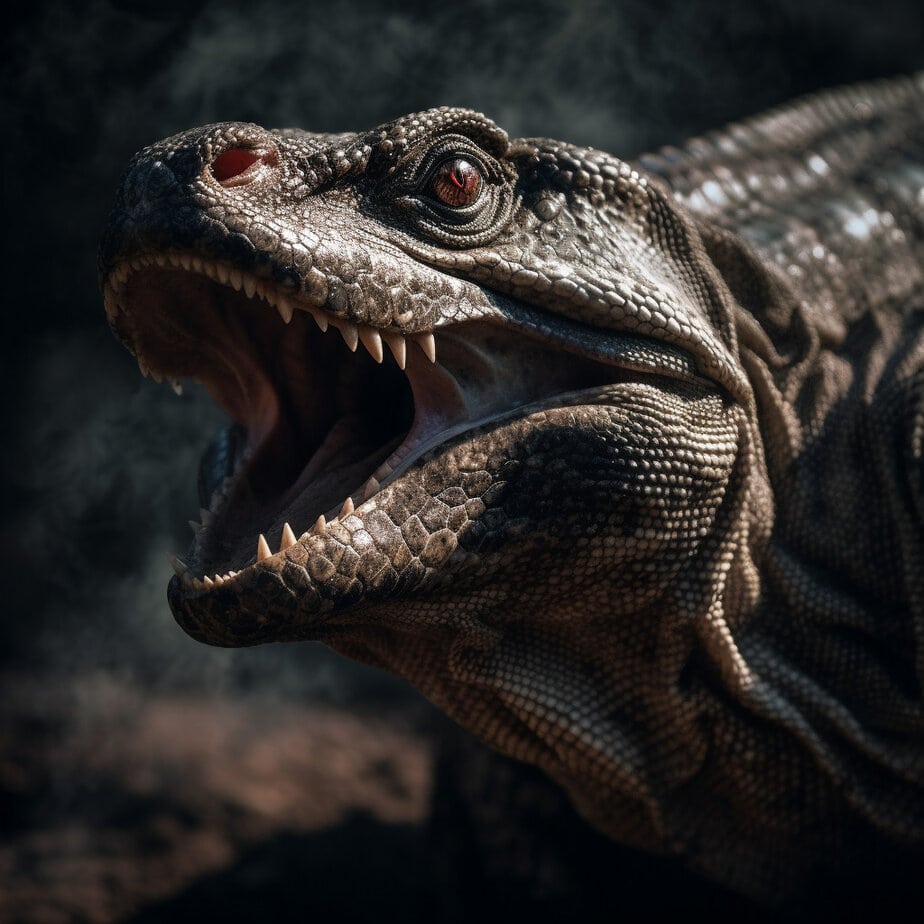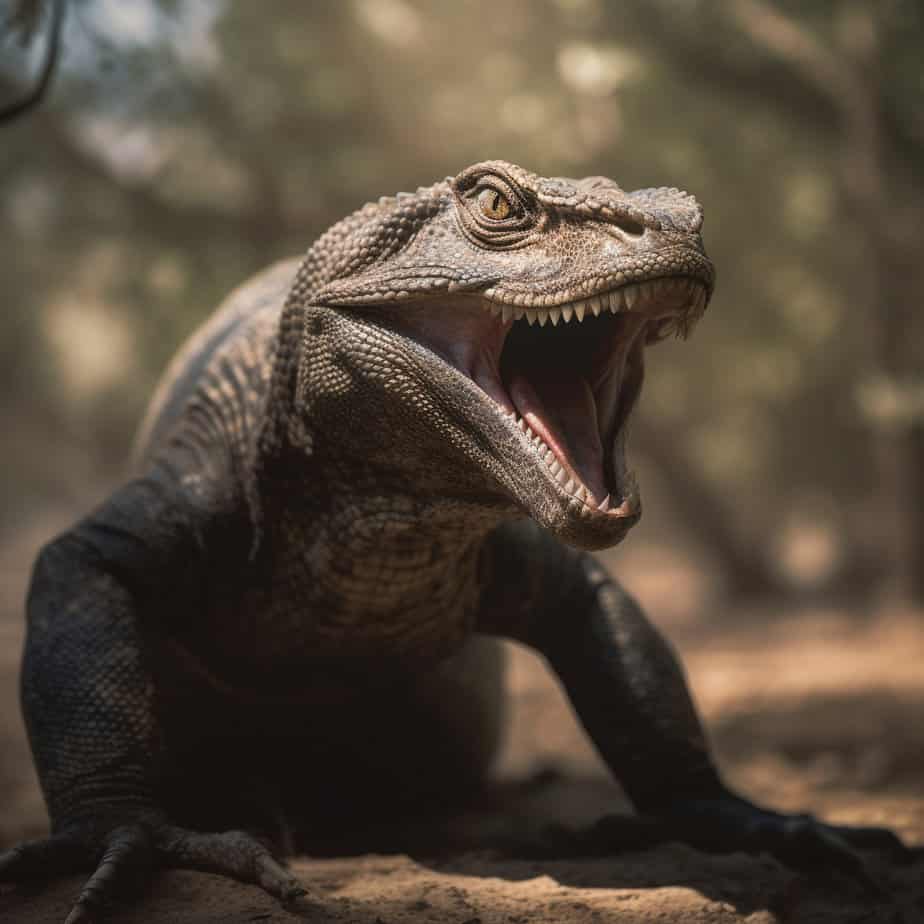The Komodo dragon, scientifically known as Varanus komodoensis, is a fascinating and formidable creature that inhabits the Indonesian islands of Komodo, Rinca, Flores, Gili Motang, and Padar. These giant lizards are known for their impressive size, reaching lengths of up to 10 feet and weighing up to 150 pounds. While their size alone is intimidating, it is the Komodo dragon’s bite that truly sets it apart. With a bite force that rivals that of a crocodile, the Komodo dragon’s jaws are equipped with sharp, serrated teeth that can inflict serious damage. In this article, we will delve into the details of a Komodo dragon bite, exploring its strength, venom, and the implications it has for both the dragon and its prey. So, let’s dive into the world of the Komodo dragon and uncover the secrets of its powerful bite.
Key Takeaways
- Komodo dragons have a powerful bite that can cause serious injury or death to their prey.
- Their saliva contains harmful bacteria that can lead to infection.
- Komodo dragons use their bite to immobilize and weaken their prey before consuming it.
- Understanding the strength and dangers of a Komodo dragon bite is important for safety and conservation efforts.
The Komodo Dragon: A Brief Overview
A. Understanding the Komodo Dragon
The Komodo dragon, scientifically known as Varanus komodoensis, is a fascinating reptile that is native to the Indonesian islands of Komodo, Rinca, Flores, Gili Motang, and Padar. It is the largest lizard species in the world, with some individuals reaching lengths of up to 10 feet and weighing over 150 pounds. These impressive creatures have captured the imagination of people worldwide due to their unique characteristics and behaviors.
Komodo dragons are well-adapted to their harsh environment, which consists of dry savannahs and tropical forests. They have a muscular build, strong limbs, and sharp claws that enable them to move swiftly and climb trees when necessary. Their scaly skin is a combination of gray, brown, and green, providing excellent camouflage among the flora of their habitat.
One of the most intriguing aspects of the Komodo dragon is its ability to reproduce through parthenogenesis, a process where unfertilized eggs develop into offspring. This phenomenon occurs in female Komodo dragons in the absence of males, allowing them to maintain a stable population even in isolated environments like zoos.
B. The Komodo Dragon’s Diet
Komodo dragons are apex predators, meaning they are at the top of the food chain in their ecosystem. Their diet primarily consists of carrion, but they are also skilled hunters. These formidable creatures have a keen sense of smell, which helps them locate decaying flesh from miles away. Once they find their prey, they use their long, sharp teeth to tear off chunks of meat.
While their bite alone is powerful, it is not the main cause of their prey’s demise. Komodo dragons possess venom glands in their lower jaws, which inject toxic saliva into their victims. This venom contains a cocktail of bacteria that can cause septicemia, a life-threatening condition characterized by blood poisoning. The combination of the dragon’s venom and the bacteria in its saliva weakens the prey, making it easier for the Komodo dragon to overpower and consume it.
Komodo dragons are opportunistic feeders and will eat almost anything they can catch, including deer, pigs, water buffalo, and even smaller Komodo dragons. They are known for their ability to take down prey much larger than themselves, thanks to their powerful jaws and serrated teeth. Once the prey is subdued, the Komodo dragon uses its sharp teeth to tear apart the flesh, consuming both the meat and bones.
In conclusion, the Komodo dragon is a remarkable creature that has evolved unique adaptations to survive in its harsh environment. Its size, strength, and venomous bite make it a formidable predator, capable of taking down large prey. Understanding the behavior and diet of these fascinating reptiles is crucial for appreciating their role in the delicate balance of the ecosystems they inhabit.
The Power Behind the Komodo Dragon’s Bite
A. The Force of a Komodo Dragon Bite: PSI Explained
When it comes to the animal kingdom, few creatures can match the power and ferocity of the Komodo dragon. These formidable reptiles are known for their massive size, sharp teeth, and, most notably, their incredibly strong bite. The force behind a Komodo dragon’s bite is truly awe-inspiring.
To understand the power of a Komodo dragon’s bite, we need to delve into the concept of PSI, or pounds per square inch. PSI is a unit of pressure used to measure the force exerted over a given area. In the case of the Komodo dragon, its bite force has been measured at an astonishing 600 PSI.
To put this into perspective, consider that the average human bite force is around 150 PSI. This means that a Komodo dragon’s bite is four times stronger than that of a human. Such immense force allows these dragons to easily overpower their prey, which can include large mammals such as deer and water buffalo.
B. Strength of Komodo Dragon Bite: How Strong is It Really?
While the PSI measurement gives us a general idea of the force behind a Komodo dragon’s bite, it’s important to note that bite strength is not solely determined by PSI. Other factors, such as the size and shape of the teeth, also play a significant role.
Komodo dragons have sharp, serrated teeth that are perfectly adapted for tearing through flesh. These teeth, combined with the immense bite force, allow these reptiles to deliver devastating injuries to their prey. Once a Komodo dragon sinks its teeth into its victim, it can cause severe damage, making it difficult for the prey to escape.
Furthermore, the Komodo dragon’s bite is not only powerful but also potentially deadly. While the bite itself can cause significant trauma, it is the bacteria present in the dragon’s saliva that poses the greatest threat. Komodo dragons have a mouth teeming with bacteria, which can lead to septicemia, a life-threatening condition characterized by a severe infection in the bloodstream.
In addition to the immediate danger posed by the bite, the bacteria in a Komodo dragon’s mouth can also cause long-term effects. If the prey manages to escape the initial attack, it may still succumb to the infection caused by the dragon’s saliva. This makes the Komodo dragon a formidable predator, capable of inflicting both immediate and long-lasting damage.
In conclusion, the power behind a Komodo dragon’s bite is truly remarkable. With a bite force of 600 PSI and sharp, serrated teeth, these reptiles are well-equipped to take down prey much larger than themselves. However, it is not just the force of the bite that makes the Komodo dragon dangerous. The bacteria in their saliva can lead to severe infections, making their bite potentially lethal. The combination of strength and deadly bacteria makes the Komodo dragon one of the most formidable predators in the animal kingdom.
The Anatomy of a Komodo Dragon Bite
A. What Does a Komodo Dragon Bite Look Like?
When it comes to the formidable Komodo dragon, one cannot help but wonder about the power and impact of its bite. The Komodo dragon, scientifically known as Varanus komodoensis, is the largest lizard species in the world, and its bite is a force to be reckoned with.
The Komodo dragon’s bite is characterized by its sheer strength and ferocity. With a mouth full of sharp, serrated teeth, the dragon is capable of inflicting serious damage on its prey. The teeth are curved, allowing for a firm grip on the victim, while the serrations aid in tearing flesh apart.
The bite itself is often accompanied by a loud, bone-crushing sound, which is a testament to the immense power behind the dragon’s jaws. The force exerted by the bite is so strong that it can easily break bones and cause severe injuries.
B. Komodo Dragon Bite Mark: Identifying the Wound
Identifying a Komodo dragon bite mark can be a challenging task, given the unique characteristics of the dragon’s bite. However, there are certain signs that can help in recognizing a bite inflicted by this fearsome predator.
-
Size and Shape: A Komodo dragon bite mark is typically large and irregular in shape. The size of the bite mark can vary depending on the size of the dragon and the victim. In some cases, the bite mark may be as long as 10 inches or more.
-
Puncture Wounds: The bite mark usually consists of multiple puncture wounds caused by the dragon’s sharp teeth. These puncture wounds are often deep and can penetrate through the victim’s skin, muscles, and even bones.
-
Bruising and Swelling: The area around the bite mark may exhibit signs of bruising and swelling. This is a result of the immense force applied by the dragon’s jaws during the bite.
-
Bleeding: A Komodo dragon bite is likely to cause significant bleeding due to the deep puncture wounds. The bleeding may be profuse and can continue for an extended period.
-
Infection: One of the most concerning aspects of a Komodo dragon bite is the risk of infection. The dragon’s saliva contains a variety of bacteria, which can lead to severe infections if not treated promptly. It is essential to seek medical attention immediately after a Komodo dragon bite to prevent complications such as septicemia.
In conclusion, a Komodo dragon bite is a formidable weapon that showcases the immense power and strength of this apex predator. The bite mark left behind is characterized by its size, shape, puncture wounds, bruising, swelling, and the risk of infection. Understanding the anatomy of a Komodo dragon bite can help in identifying and treating the wound effectively.
The Toxicity of a Komodo Dragon Bite
A. Komodo Dragon Bite: Venom or Bacteria?
When it comes to the Komodo dragon, one of the most fascinating aspects of its bite is the debate surrounding whether it is venomous or if the bacteria in its mouth is the main culprit. For many years, scientists believed that the Komodo dragon’s bite was deadly due to the presence of venom. However, recent research has shed new light on this topic.
Contrary to popular belief, the Komodo dragon does not possess venom glands like other venomous reptiles. Instead, it has been discovered that the bacteria in its saliva plays a significant role in the toxicity of its bite. The mouth of a Komodo dragon is teeming with a variety of bacteria, including strains that are known to cause infections in prey animals.
When a Komodo dragon bites its prey, the bacteria in its mouth are introduced into the wound. These bacteria, such as Salmonella and Staphylococcus, can quickly multiply and cause severe infections. The combination of the Komodo dragon’s powerful bite and the bacteria in its saliva can lead to a dangerous and potentially deadly situation for its prey.
B. How Deadly is a Komodo Dragon Bite?
While the Komodo dragon’s bite may not be venomous in the traditional sense, it is still incredibly deadly. The combination of the reptile’s powerful jaws and the bacteria in its saliva can lead to severe infections and even death.
When a Komodo dragon bites its prey, it inflicts deep wounds that are difficult to heal. The bacteria in its saliva can cause septicemia, a life-threatening condition characterized by the presence of bacteria in the bloodstream. If left untreated, septicemia can lead to organ failure and death.
In addition to the immediate danger posed by the bacteria in its saliva, the Komodo dragon’s bite can also have long-term effects. The deep wounds inflicted by its sharp teeth can leave prey animals vulnerable to further infections and complications. Even if the initial infection is treated, the long-term consequences of a Komodo dragon bite can be severe.
C. The Aftermath of a Komodo Dragon Bite: Infection and Effects
The aftermath of a Komodo dragon bite can be devastating for both humans and animals. The bacteria in the reptile’s saliva can cause severe infections that require immediate medical attention. If left untreated, these infections can lead to septicemia, a condition that can be fatal.
In humans, a Komodo dragon bite can result in symptoms such as pain, swelling, and redness at the site of the wound. If an infection develops, additional symptoms such as fever, chills, and fatigue may occur. Prompt medical treatment is essential to prevent the infection from spreading and causing further complications.
For prey animals, the consequences of a Komodo dragon bite can be even more dire. The combination of the reptile’s powerful bite and the bacteria in its saliva can lead to a slow and painful death. The prey animal may succumb to septicemia or other complications caused by the infection.
In conclusion, while the Komodo dragon’s bite may not contain venom, it is still incredibly dangerous. The bacteria in its saliva can cause severe infections that can be fatal if left untreated. Whether it is the venom or the bacteria that makes the Komodo dragon’s bite so deadly, one thing is certain – encountering this formidable reptile in the wild is not an experience to be taken lightly.
The Impact of a Komodo Dragon Bite on Humans

A. What Happens if a Komodo Dragon Bites You?
Komodo dragons, the largest lizards on Earth, are formidable predators known for their powerful bite. While these reptiles primarily prey on animals like deer and water buffalo, there have been instances where humans have been bitten by Komodo dragons. So, what happens if you find yourself on the receiving end of a Komodo dragon bite?
When a Komodo dragon bites, it can cause severe damage due to its sharp, serrated teeth and strong jaw muscles. The bite itself can be excruciatingly painful, and the force exerted by the dragon’s jaws can crush bones and tear through flesh. The saliva of a Komodo dragon contains a mix of bacteria that can lead to serious infections, further complicating the wound.
B. Komodo Dragon Bite on Human: Symptoms and Treatment
If you are unfortunate enough to be bitten by a Komodo dragon, it is crucial to seek medical attention immediately. The symptoms of a Komodo dragon bite can vary depending on the severity of the injury and the presence of any secondary infections. Here are some common symptoms:
-
Severe pain: The bite will likely cause intense pain due to the deep tissue damage inflicted by the dragon’s teeth.
-
Bleeding: Komodo dragon bites can result in significant bleeding, which may be difficult to control without medical intervention.
-
Swelling and inflammation: The area around the bite may become swollen and inflamed as a result of the trauma and the body’s immune response.
-
Infection: The bacteria present in a Komodo dragon’s saliva can lead to serious infections. Symptoms of infection may include redness, warmth, pus, and fever.
-
Necrosis: In severe cases, the tissue around the bite may die, leading to necrosis. This can further complicate the healing process and may require surgical intervention.
When it comes to treating a Komodo dragon bite, prompt medical attention is crucial. The wound will need to be thoroughly cleaned and disinfected to prevent infection. Antibiotics may be prescribed to combat any bacterial contamination. In some cases, surgery may be necessary to remove damaged tissue or address complications such as necrosis.
C. Survival Rate: Can You Survive a Komodo Dragon Bite?
Surviving a Komodo dragon bite is possible, but it largely depends on the severity of the injury and the promptness of medical treatment. Komodo dragon bites can be life-threatening due to the risk of infection and the potential for severe tissue damage. If left untreated, the bacteria in the dragon’s saliva can cause septicemia, a life-threatening condition characterized by the spread of bacteria throughout the body.
However, with immediate medical intervention, the chances of survival increase significantly. Timely administration of antibiotics and proper wound care can help prevent the development of serious infections. Additionally, surgical procedures may be performed to address any complications and promote healing.
It is important to note that while Komodo dragon bites on humans are rare, they should not be taken lightly. These creatures are powerful predators with a bite force capable of causing significant harm. It is always advisable to exercise caution and maintain a safe distance when encountering Komodo dragons in their natural habitat.
In conclusion, a Komodo dragon bite can have severe consequences for humans. The impact of the bite includes intense pain, tissue damage, the risk of infection, and potential complications. Seeking immediate medical attention is crucial to increase the chances of survival and minimize the long-term effects of the bite.
The Komodo Dragon Bite on Meat
A. Komodo Dragon Bites Meat: Observing the Impact
When it comes to the Komodo dragon, one cannot help but be fascinated by its powerful bite. These formidable creatures are known for their ability to take down large prey, including deer and water buffalo, with a single bite. Let’s take a closer look at the impact of a Komodo dragon bite on meat.
When a Komodo dragon bites into its prey, the force exerted by its jaws is immense. With sharp, serrated teeth, the dragon is able to tear through flesh and bone effortlessly. The bite itself is often accompanied by a strong grip, ensuring that the prey cannot escape. This combination of biting and gripping allows the Komodo dragon to immobilize its prey, making it easier for the dragon to consume its meal.
B. Why is a Komodo Dragon Bite Especially Dangerous to Prey?
The Komodo dragon’s bite is not only powerful but also dangerous to its prey for several reasons. Firstly, the saliva of a Komodo dragon contains a variety of bacteria, which can lead to severe infections. These bacteria, such as Pasteurella multocida and Providencia rettgeri, can cause septicemia, a life-threatening condition characterized by the presence of bacteria in the bloodstream. This means that even if the prey manages to escape the initial attack, it may succumb to the bacterial infection later on.
Secondly, the Komodo dragon’s bite can cause significant damage to the prey’s tissues. The dragon’s teeth are designed to tear through flesh, resulting in deep wounds that are difficult to heal. Additionally, the dragon’s saliva contains venom, which further aids in immobilizing the prey and breaking down its tissues for easier consumption.
Lastly, the Komodo dragon’s hunting behavior adds to the danger of its bite. These creatures are known for their stealth and patience when stalking their prey. They often wait for the perfect moment to strike, catching their victims off guard. This element of surprise, combined with the dragon’s powerful bite, makes it extremely difficult for the prey to defend itself or escape.
In conclusion, the Komodo dragon’s bite on meat is a force to be reckoned with. Its powerful jaws, accompanied by sharp teeth and a strong grip, allow it to immobilize its prey effectively. The presence of bacteria in its saliva, along with the venom, makes the bite even more dangerous, leading to potential infections and tissue damage. Understanding the impact of a Komodo dragon bite on meat helps us appreciate the remarkable hunting abilities of these fascinating creatures.
How to Respond to a Komodo Dragon Bite

A. First Aid: How to Treat a Komodo Dragon Bite
If you ever find yourself in the unfortunate situation of being bitten by a Komodo dragon, it’s crucial to know how to respond quickly and effectively. While these large lizards are fascinating creatures, their bites can be extremely dangerous due to the bacteria present in their saliva. Here are some steps to take in order to provide immediate first aid for a Komodo dragon bite:
-
Stay Calm: It’s important to remain calm and composed after a Komodo dragon bite. Panicking can elevate your heart rate, potentially spreading the venom faster throughout your body.
-
Remove Yourself from Danger: If possible, move away from the Komodo dragon to prevent further attacks. Remember, these reptiles are powerful predators, and your safety should be your top priority.
-
Apply Pressure: Use a clean cloth or bandage to apply pressure to the wound. This can help slow down the bleeding and reduce the risk of infection.
-
Elevate the Wound: If the bite is on an extremity, such as an arm or leg, try to elevate it above the level of your heart. This can help minimize swelling and reduce blood flow to the area.
-
Clean the Wound: Rinse the bite wound thoroughly with clean water to remove any dirt or debris. Avoid using soap or harsh chemicals, as they can further irritate the wound.
-
Cover the Wound: Once the wound is clean, cover it with a sterile dressing or clean cloth to protect it from further contamination.
-
Seek Medical Attention: Even if the bite doesn’t appear severe, it’s crucial to seek medical attention as soon as possible. Komodo dragon bites can lead to serious infections, and prompt medical intervention is necessary to prevent complications.
B. How to Cure a Komodo Dragon Bite: Medical Intervention
While providing immediate first aid is essential, medical intervention is crucial for the proper treatment of a Komodo dragon bite. Here are some medical procedures and treatments that may be involved in the cure of a Komodo dragon bite:
-
Antibiotics: Since Komodo dragon saliva contains a variety of bacteria, including zoonotic bacteria, antibiotics are typically prescribed to prevent or treat infection. These medications help kill the bacteria and prevent the development of septicemia, a potentially life-threatening condition.
-
Tetanus Shot: Tetanus is a bacterial infection that can enter the body through open wounds. To prevent tetanus, a tetanus shot may be administered if your immunization status is not up to date.
-
Wound Debridement: In some cases, the wound may need to be cleaned more thoroughly through a procedure called wound debridement. This involves removing any dead tissue or foreign objects from the wound to promote healing.
-
Surgical Intervention: If the bite is severe or has caused significant damage, surgical intervention may be necessary. This could involve repairing damaged tissues, closing the wound, or even amputation in extreme cases.
-
Monitoring and Follow-up: After initial treatment, it’s important to closely monitor the wound for signs of infection or other complications. Follow-up appointments with a healthcare professional are essential to ensure proper healing and prevent any long-term consequences.
Remember, a Komodo dragon bite should never be taken lightly. These reptiles have powerful jaws and carry a high risk of infection. Seeking immediate medical attention and following the recommended treatment plan is crucial for a successful recovery.
In the next section, we will explore the potential complications that can arise from a Komodo dragon bite and the importance of understanding the behavior and habitat of these fascinating creatures.
Debunking Myths: Is the Komodo Dragon Really a Dragon?

A. The Komodo Dragon: Dragon or Lizard?
When you hear the name “Komodo dragon,” you might imagine a mythical creature straight out of a fairy tale. However, the truth is that the Komodo dragon is not actually a dragon in the traditional sense. It is, in fact, a species of large lizard known as Varanus komodoensis.
The confusion surrounding the Komodo dragon’s classification as a dragon stems from its impressive size and fearsome reputation. These reptiles can grow up to 10 feet long and weigh over 150 pounds, making them the largest lizards on Earth. With their scaly skin, sharp teeth, and powerful jaws, it’s easy to see why people might mistake them for dragons.
B. The Komodo Dragon: More Than Just a Dragon
While the Komodo dragon may not possess the magical abilities often associated with dragons, it is still an incredibly fascinating creature. Found primarily in the Komodo National Park in Indonesia, these lizards have a unique set of characteristics that set them apart from other reptiles.
One of the most intriguing aspects of the Komodo dragon is its hunting behavior. Despite their massive size, these lizards are surprisingly agile and can reach speeds of up to 12 miles per hour in short bursts. They use their keen sense of smell to locate prey, which can include anything from small mammals to birds and even water buffalo. Once they have spotted their target, they rely on their powerful jaws and sharp teeth to deliver a deadly bite.
Speaking of their bite, it is worth mentioning that the Komodo dragon’s saliva contains a potent mix of bacteria. Contrary to popular belief, this bacteria is not venomous but rather serves a different purpose. When a Komodo dragon bites its prey, the bacteria in its saliva can cause septicemia, a severe bacterial infection. This infection weakens the prey, making it easier for the Komodo dragon to overpower and eventually devour it.
While the Komodo dragon’s bite is indeed dangerous, it is important to note that these lizards do not typically attack humans. They are generally shy and prefer to avoid human contact. However, if provoked or cornered, they may defend themselves, and their bite can be lethal if left untreated.
In conclusion, while the Komodo dragon may not possess the mythical qualities often associated with dragons, it is still a remarkable creature in its own right. Its size, hunting behavior, and unique saliva make it a fascinating subject of study for scientists and nature enthusiasts alike. So, the next time you come across a Komodo dragon, remember that although it may not breathe fire or fly, it is still a creature worthy of awe and respect. Conclusion
In conclusion, the bite of a Komodo dragon is a formidable weapon that allows these impressive reptiles to overpower and subdue their prey. With their sharp teeth, powerful jaws, and potent venom, Komodo dragons are able to inflict serious injuries on their victims. Their bite is not only strong enough to tear through flesh and bone, but it also introduces a deadly cocktail of bacteria into the wound, which can lead to a slow and painful death for their prey. Despite their fearsome reputation, Komodo dragons primarily use their bite for hunting and feeding purposes, rather than as a means of attacking humans. However, it is important to exercise caution and respect when encountering these magnificent creatures in their natural habitat to ensure both their safety and ours.
Frequently Asked Questions
1. What is a Komodo dragon?
A Komodo dragon, scientifically known as Varanus komodoensis, is a species of large lizard native to the Indonesian islands of Komodo, Rinca, Flores, and Gili Motang. They are the largest living species of lizard and are known for their powerful bite and venomous saliva.
2. Is a Komodo dragon really a dragon?
No, a Komodo dragon is not a mythical dragon as depicted in folklore and popular culture. It is a type of large lizard, hence the name ‘dragon’ due to its size and fearsome appearance.
3. What does a Komodo dragon eat?
Komodo dragons are carnivores, meaning they eat meat. Their diet consists of carrion, deer, pigs, smaller dragons, and even large water buffalo. They are also known to eat humans in rare instances.
4. How deadly is a Komodo dragon bite?
A Komodo dragon bite can be extremely deadly due to the combination of their strong bite force, sharp teeth, and venomous saliva. The saliva contains a mix of toxic proteins and zoonotic bacteria, which can cause septicemia and serious infection if not treated promptly.
5. What happens if a Komodo dragon bites you?
If a Komodo dragon bites you, it can cause a serious bacterial infection due to the venom and bacteria present in their saliva. Symptoms can include severe pain, swelling, and even septicemia. Immediate medical attention is necessary to treat the wound and prevent complications.
6. Can you survive a Komodo dragon bite?
Yes, it is possible to survive a Komodo dragon bite with prompt and proper medical treatment. However, the bite is extremely painful and can lead to serious infection and complications if not treated immediately.
7. How strong is a Komodo dragon’s bite force?
A Komodo dragon‘s bite force is estimated to be between 39 to 60 PSI (Pounds per Square Inch). This, combined with their sharp teeth and venomous saliva, makes their bite particularly dangerous.
8. Why is a Komodo dragon bite especially dangerous?
A Komodo dragon bite is especially dangerous due to the combination of their strong bite force, sharp teeth, and venomous saliva. The saliva contains a mix of toxic proteins and zoonotic bacteria, which can cause septicemia and serious infection if not treated promptly.
9. What is the habitat of a Komodo dragon?
Komodo dragons are native to the Indonesian islands of Komodo, Rinca, Flores, and Gili Motang. They inhabit tropical savanna forests, but are also found in grasslands, mangroves, and coral reefs within the Komodo National Park.
10. How long does a Komodo dragon live?
Komodo dragons have a lifespan of about 30 years in the wild. Their longevity is attributed to their slow metabolism and robust immune system.




